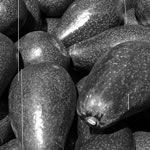
Avocado History
Avocado History
Till the end of the 1970’s phytophthora root rot was the number one problem facing avocado growers in most production areas around the world. Without a healthy root system inputs such as fertilizers, irrigation and weed control can be largely a waste of time and money, and mature trees can decline rapidly and die.
In the late 70’s two new fungicides appeared on the market with the potential to control phytophthora rot root, these fungicides where Ridomil, ground applied and Aliette a phosphorous acid based salt, applied by foliar spray . At Westfhalia Farms in South Africa, the largest avocado farm in the world,both products where trailed, subsequently neither were considered to be cost effective.
A plant pathologist, Dr. Josef Darvas, working for Westfhalia theorized that the effectiveness of Aliette could be greatly increased by direct injection into the tree’s xylem, subsequent trials proved very successful and the procedure was adopted at Westfhalia as standard treatment for phytophthora.
On learning of the Darvas/Westfhalia practice Rhone-Poulenc, manufacture of Aliette initiated legal action against Westfalia for unregistered method of use of a fungicide and cut off all supply to them.
Darvas realized that most of the anti phytophthora effect of Alliette was from the phosphorous acid component and that it should be possible to achieve similar results injecting diluted phosphorous acid. Again trials proved Darvas correct and now with a material of very low cost.
Rhone-Poulenc again took legel action against Westfalia, this time for patent infringement. [ Many years later all actions were dismissed by the South African Courts]
In the early 80’s Australian avocado growers became aware that South African Growers had something that could effectively control phytophthora, researchers from Queensland State Dept. of Primary Industries where sent to South Africa to investigate. They returned learning only that phosphorous acid was being injected into the trees.
Initial trials in Australia involved unbuffered phosphorous acid which caused serve leaf burn and posed a high risk of injury to the operator of the injection equipment.
To overcome these problems phosphorous acid was partly neutralized by the addition of potassium hydroxide.
The resultant pH. Of the phosphonate was between 5.5 and 6.0 this overcame some of the leaf burn problems, was a much less dangerous material to work with and gave a satisfactory level of control.
The formulation was commercialized, being manufacture by a small chemical company in Brisbane, Australia. Once again Rhone-Poulenc had writs issued for patent infringement. This was quickly dealt with by the Australian Courts, the judge ruling against Rhone -P.
In the early 90’s UC Riverside took out a patent and had phosphorous acid registered as a fertigation applied fertilizer, and let it be known that this would control phytophthora.
About the same time a senior researcher in Australia was making similar claims, ie that “ground application of phosphonates was the way to go”. Many Australian growers took up the practice.
Whilst “drenching” of nursery stock and young trees has proved very successful in keeping phytophthora at bay the practice of fertigating phosponates in mature orchards proved ineffective.
Subsequent research revealed that to achieve the same level of effectiveness by fertigation $ 27 per tree of posphonate had to be ground applied per year as against 25 cents worth injected.
Optimizing the pH. Of Injected Phosphonate.
In the late 90’s Dr. Clive Kaiser whilst working in Australia considered the pH.[5.5-6.0] of the phosphonates being injected and the effects they where having on trees ie. leaf burn to a larger or smaller or larger degree depending on season or weather conditions.
Plant material has a pH. of 7.2 and therefore by adjusting the pH. of the phosphonate to 7.2 leaf burn should be greatly reduced and in fact the phosphonate should be more readily absorbed through the leaves, field trials confirmed this to be true.
Ongoing research has reviled that the benefits of foliar application of phosphonates are not as great as first thought.
Tested root sample revile that phosphonate levels from foliar application rise rapidly but then decline soon after to relatively low levels by comparison the injected material.
Monitoring phosphonate levels in roots
Casco Agritech of Toowoomba, Analytical Chemists in conjunction with Horticultural Consultant, Graeme Thomas have developed an economical method of measuring root phosphonate levels.
This is probably the most important breakthrough since the discovery of the effectiveness of phosphonates.
For the first time producers have a cost effective method of monitoring the effectiveness of their phosphonate treatment and thereby the knowledge to be able to accurately adjust it to suit their own farms needs.
Root monitoring is particularly important as the recommended dose rates for phosphonate injection are highly suspect being based on the canopy diameter rather than root area.
Warning — Read the pesticide manufacturers label before using with this injector system. It is an offence to use product for a purpose or in a manor other than as stated on that label, unless there is in place a current 24/c permit for the purpose proposed.
UNDER NO CIRCUMSTANCE THIS OR ANY SIDEWINDER INJECTORS TO BE USED WITH UNBUFFERED PHOSPHOROUS OR PHOSPHORIC ACID PRODUCTS SUCH AS 0-60-0 AS IT COULD CAUSE SUDDEN FAILURE OF SOME INJECTOR PARTS AND PLACE THE OPERATOR AT RISK OF SERIOUS INJURY.